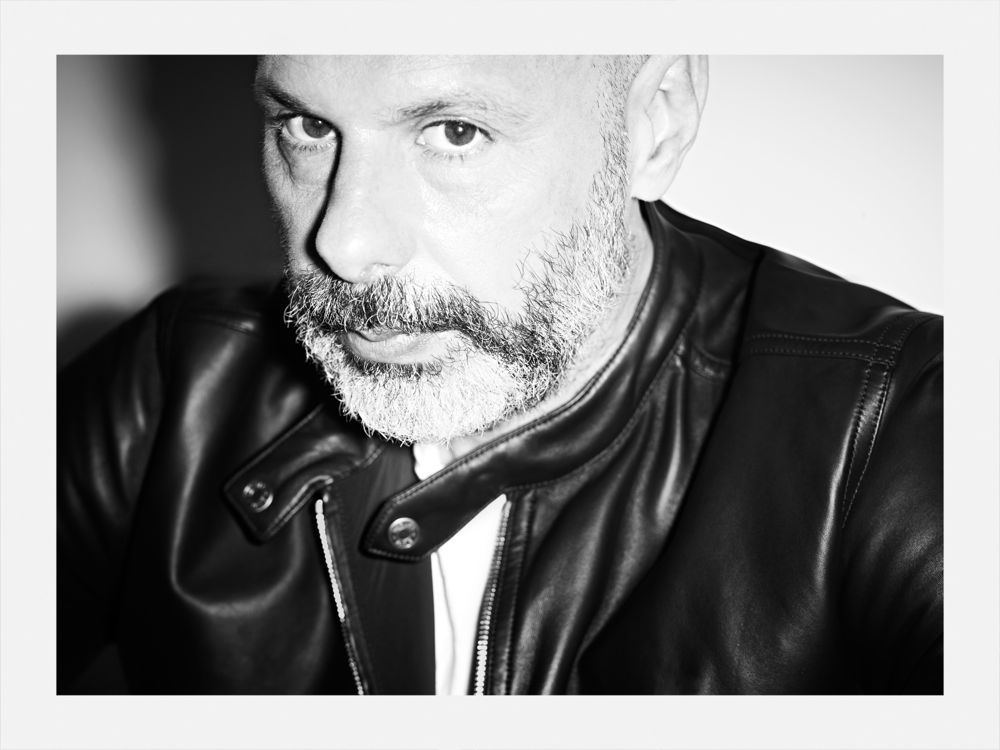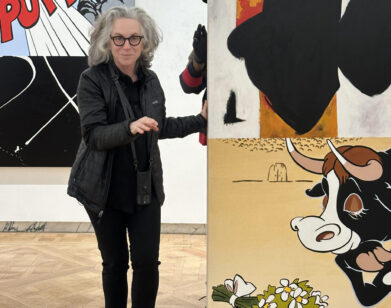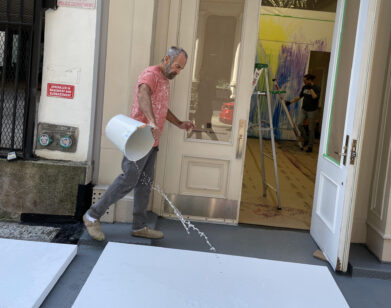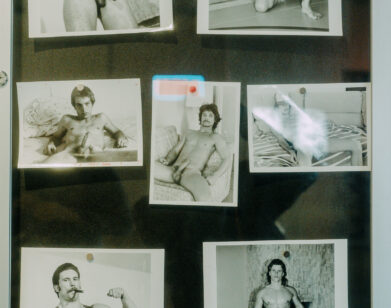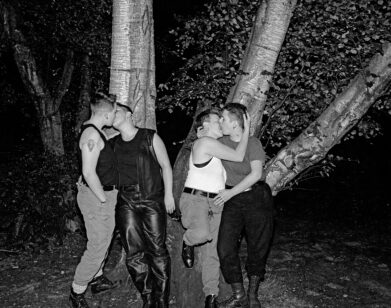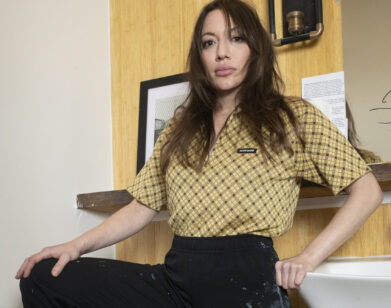Philippe Parreno
WE TRY TO IMAGINE THINGS AND WE DON’T KNOW EXACTLY WHERE THAT WILL LEAD US. FOR ME THAT IS WHAT MAKING ART IS ALL ABOUT.philippe parreno
Whether Philippe Parreno’s show in Paris this fall is the biggest solo exhibition ever given over to a single living artist (as has been claimed), it is undeniably the biggest show that the Palais de Tokyo has ever hosted: this October, all 236,000 square feet of the gallery space will be filled with the 49-year-old Parreno’s volatile blend of sights, stages, and sounds in an immersive, all-encompassing art experience.
Such monumentality is only fitting for a man who works on a scale as epic as Parreno does. In the past two decades, he has almost single-handedly reshaped the very notion of what it means to “experience” art by turning the dynamics of a show into an evolving, situational process. Parreno is often cast as the typification of the favorite art-world term relational aesthetics, but his productions—largely collaborative and cinematic—seem intent on capturing human agencies art has always attempted to convey: character, landscape, the impact of history or psychology. For Parenno, all of that is just on more shifting ground.
Parreno’s overall plan for the Palais de Tokyo show is less a retrospective and more of a new artistic entity all its own. Under the ethereal title “Anywhere, Anywhere Out of the World,” he is taking over not only the museum interior, but the architecture itself. The experience will no doubt be as beautifully destabilizing as its title.
In 1999, Parreno, along with artist Pierre Huyghe, bought the copyright to a manga character named Annlee, liberating her from her comic-book fate but eventually releasing her—through the No Ghost Just a Shell series of animated videos—into a gray zone that she haunts indefinitely. In 2009, with the help of cinematographer Darius Khondji, Parreno created a film ode to the famous train transport of Robert Kennedy’s body from New York to Washington. Titled June 8, 1968, the reenactment footage froze on sun-bleached scenes of lone voyeurs on the side of the tracks, as if history had not so much been repeated but was never finished in the first place. Perhaps his most famous work, which brought him in collaboration with Khondji and artist Douglas Gordon, was the 2006 film Zidane: A 21st Century Portrait. Shot with 17 cameras that followed iconic footballer Zinedine Zidane through the course of a 90-minute match, the film spectacularly documented the friction between individual and crowd, hero and man. All 17 camera angles that comprised Zidane will be incorporated into the Palais de Tokyo show, along with the more recent films C.H.Z. (2011), which imagines life forms and vegetation on a distant planet, and Marilyn (2012), which captures the ghostly presence of the dead Hollywood star in her suite at the Waldorf Astoria hotel.
Parreno recently traveled to the very real place of Nice in the South of France, where his longtime collaborator Khondji was working on a film with Woody Allen. The two met at Hôtel La Pérouse to discuss Parreno’s attraction to other worlds.
DARIUS KHONDJI: I remember a project that you wanted to do a while ago—the idea of shooting off black fireworks during the day.
PHILIPPE PARRENO: We nearly did it. It would have been nice to do it on a blue sky, like this one over La Baie des Anges [in Nice].
KHONDJI: Black fireworks would be like scratches in the sky.
PARRENO: I went to Spain to meet these guys who produce the rockets for fireworks. But EU laws didn’t allow us to use the black powder needed to produce those kinds of rockets. It was not so easy.
KHONDJI: I wish we could do that at the end of the Frankenstein film we want to do. The camera panning into the sky … What interested you in doing a film on Frankenstein?
PARRENO: Frankenstein, the book, is ultimately about loneliness and creation. The author, Mary Shelley; the scientist, Victor; and the monster are all in different worlds but they live in the same time line. They share time but not a universe. Mary belongs to history. Victor lives in fiction. And the monster lives in the fantasmic, imaginary world. It’s like three different levels in a video game. Except, when the monster meets Victor, he breaks the rules of going from one world to another. Even the book’s narrator, Walton, is in his own universe—he’s telling the story from a boat in the middle of the ocean.
KHONDJI: It’s like musical partitions. They rarely cross into each other.
PARRENO: Yes, you have the wind instruments, you have the strings—they follow each other but they don’t really meet.
KHONDJI: And then suddenly there is an imperfection that happens, a glitch almost, and the lines cross. It’s like in Navajo rugs, where they keep the devil away by putting an imperfect thread in the otherwise perfect canvas. The director John Ford always said he wanted his movies to be like Navajo rugs. He wanted something imperfect in his movies to chase the devil away.
PARRENO: In our Frankenstein piece, we will have certain elements that repeat to create that bridge, or crossing—like the lake and mountains we show in Mary Shelley’s world will also be the fictional world.
KHONDJI: Yes, we’ll repeat the same landscape but shoot it at different angles. It’s the angle that shows how we see differently. I have always believed that all documentaries are fictional. It’s really the angle of the camera, the owner of the perception, that makes the story what it is. The video camera is a fiction. So for our three worlds, it’s just a matter of a shift in angle. And maybe the weather is different in each. In one, it can be storming, in another, serene.
PARRENO: There is a line I want to read you from Alain Robbe-Grillet’s novel In the Labyrinth. It’s about contradiction. “I’m alone here now, undercover; outside it is raining, shielding your eyes with one hand while you stare ahead, nevertheless, a few yards ahead, at a few yards of wet asphalt, outside it is cold, the wind blows through the leaves, rocking whole boughs, rocking them, rocking, their shadows swaying across the white roughcast walls. Outside the sun is shinning, there is no tree, no bush to cast a shadow, and you walk under the sun shielding your eyes with one hand while you stare ahead, only a few yards of dusty asphalt where the wind makes patterns of parallel lines, forks and spirals.” In this one sentence there are contradictions. I like how he creates this ontological impossibility. You continue in time but you are not in the same space—or the same weather. So you change perspective, alternate the space although nothing has really changed; it’s just raining. You and I have worked together for eight years. Today we are discussing landscapes but we started out doing portraiture together. Zidane was a portrait. And of course June 8, 1968 and Marilyn are funeral portraits. Now our Frankenstein piece is like a gallery of portraits, like when you walk into a museum and see one picture after another and you start to make correlations. It works because Frankenstein is an epistolary novel. They write letters that are linked together. Of course, what makes a movie a movie and not a painting is the fact that, in a movie, you never have only one character. You have a relation between characters. It would be the first time with Frankenstein that I will address that, you know?
KHONDJI: We could shoot the monster from his perspective or just behind him, following him as he walks and seeing the nature he sees.
PARRENO: I remember when we were doing the mixing for Zidane with Douglas [Gordon], and we tried to put all the presence of Zidane into the piece instead of putting him in the middle of the screen, as you do in cinema. It was a really weird feeling. And it was a totally schizophrenic picture. You have this guy moving, running around, and then the sound of him behind … That was the mise-en-scène. It’s kind of like looking at a painting. The attention to the picture can be driven in a nonauthoritarian man—ner either through sound or a shift of light. It gives you space to drift. I think that’s what we succeeded in doing in Zidane. After a while, you start to drift out of the picture. It’s quite pleasant. It was a bit like when someone else is driving a car and you are in the backseat and you can drift and see the landscape. You’re still in the car, but you’re drifting. That also happens a lot when you read a book—you go out from the book. That’s why you and I like to use 65mm film. It gives you room to fill the space with your mind rather than with the story that’s being told. It’s like in silent movies how there are labels between the frames—intertitles. I always liked that separation between action and word.
KHONDJI: Zidane was also about using different angles—creating a portrait of him from a multi-prism of shots. The first time you and I met to discuss Zidane, you told me your idea of multiple cameras given to the fans and I was really scared of how to do it. But the rationality of production is really a creative process. You and Douglas wanted a delirium of points of view. All eyes looking at Zidane. It was very beautiful.
PARRENO: The multiple points of view around the event of Zidane came from a text by Pier Paolo Pasolini that talks about the shooting of John F. Kennedy. That it was seen from so many different angles. Pasolini was saying that if you multiply the point of views around the event to infinity, when you want to play it back, the event never takes place—the bullet never hits the target.
KHONDJI: Speaking of assassination, you and I took on a different approach when we did June 8, 1968. That had the sort of opposite imagery. It was the purer, more direct viewing of people watching.
IT’S ALL ABOUT CONVERSATIONS, DISCUSSIONS, AND PUSHING AN IDEA ONE WAY OR ANOTHER. AND ONCE YOU START, YOU CAN’T STOP. YOU HAVE TO FOLLOW IT TO THE END OF THE JOURNEY. philippe parreno
PARRENO: Yes, instead of looking at an event, which is the case in Zidane of looking at the subject, this star, it was about being in the place of the event, being the dead. We traced the journey of Robert Kennedy’s body from New York to Washington and the viewers who waited along the tracks to view a dead person. That was about reversing the camera. After we finished Zidane and June 8, 1968, we talked about shooting a film together called The Crowd, remember?
KHONDJI: Yes, yes. It was based on the Heysel Stadium disaster during the European Cup final. [On May 29, 1985, fans were pressed against a wall in the Heysel Stadium in Brussels, Belgium, before the start of the European Cup final between Juventus of Italy and Liverpool of England. Thirty-nine people died and 600 were injured.]
PARRENO: After Zidane, I thought it would be interesting to be in the crowd trying to shoot these dramatic events through multiple points of view. This might be a good time to ask you: How is it to go from working on these experimental films with me to shooting a feature film with Woody Allen or David Fincher?
KHONDJI: It’s not very different. It’s always an enterprise. It’s about working on a project with a director who becomes for me almost like a soul brother. Especially with you, because our work together is particularly challenging, so we do all of this artistic research together. I never shoot 65mm unless I’m shooting with you.
PARRENO: No one uses 65mm film anymore?
KHONDJI: They used it for Lawrence of Arabia [1962] and other films in the old days. But it’s a technical challenge to figure out the perception of the film based on what is written.
PARRENO: Maybe it’s challenging because, apart from now with Frankenstein, I hardly ever write for a film. For C.H.Z. [2011], I just showed you drawings.
KHONDJI: You show me notes, and those notes give good direction—at least they do emotionally. It’s just a question of putting yourself into the right wavelength. There was a beautiful moment when we worked together on Invisible Boy [2010] where it was so easy to get lost and dizzy in making it because I didn’t really know where we were going to go. It reminded me of the actors in Jean-Luc Godard films who also said they had no idea where they were headed. Invisible Boy was like this because I didn’t know which characters would later be scratched into the film. You were just telling me ideas and you were beside me at the camera the whole time. We were filming in the middle of the night in New York and I had to leave a space for the monster, for the chimera. You were always telling me, “Leave a space for the monster.” It became an obsession for me. Working with you is always an obsessional way of filmmaking. When I do feature films, it’s much more precise in terms of a shooting schedule every day and all that.
PARRENO: That’s because when we work on a project together, we’re both looking. Before we start shooting, the project isn’t really there. We just say, for example, that we will try to picture the paranoid drift of this young Chinese illegal immigrant in New York who we met, as we did for Invisible Boy. Basically, we try to imagine things and we don’t know exactly where that will lead us. For me that is what making art is all about.
KHONDJI: Everything we’ve done is so stylized, so specific to the matter. With June 8, 1968, we worked with a crane to capture those immense scenes. And with C.H.Z., we had all of those flares shooting through the darkness. And even our work on Marilyn was so specific.
PARRENO: It was only when we were shooting Marilyn that I started reading Mary Shelley. And in a way, doing Marilyn is all about a Frankenstein experience. We are doing a film with a dead person. We had a medium conduct a séance with Marilyn Monroe’s ghost. Do you remember the medium came with a little girl the night before the shoot? And she told you something about your past, didn’t she?
KHONDJI: No. What happened is that I got in contact with my parents—with my father and mother, who both passed away years ago. Suddenly during the séance, I felt this warmth almost like a cocoon around me. Shooting Marilyn was very strange.
PARRENO: I remember at one point the medium pointed a finger at me and said, “You have a dark hole in your body.” I was just going on treatments for cancer so that was really weird. Then she started talking about my mother, who had the same disease. That kind of put us all in the mood. [laughs]
KHONDJI: It makes sense that we do Frankenstein next, bringing someone back to life.
PARRENO: I remember being touched by the novel because, even more than being about the creation of the creature or reversing death into life, it’s about characters who are really trying to tell something to each other. They are trying to confess. It’s a bit what our Marilyn in the movie is trying to do as well—she’s trying to say something but she can’t. All she can do is describe what she sees. And she does it over and over because she can’t address anything. I felt in touch with that, like when you try to say something to somebody but you can’t. Instead all you can do is repeat the same thing over and over again. And it’s not even important, what you are saying, it’s just in repeating it that the other person knows you are trying to say something. I think life is full of that—this strange notion of a “partial” truth.
KHONDJI: I love the idea that unimportant things say a lot. I wanted to ask you, what is the trigger for a project? How does your Big Bang for an idea come about?
PARRENO: Zidane didn’t even start with the idea of football. It came out of a conversation with Douglas about an idea for a film where we follow only one character all the way through a story. You never leave him, even when he crosses other characters. We were talking about that while playing football, so we decided it would be like following one player throughout a game. A game of football is 90 minutes, just like a feature film. Invisible Boy started with the name because that is the name Chinese illegal workers are given. Also, I read Lewis Carroll’s Alice in Wonderland, which is a paranoiac map of a world. So I started to pull all of these things together. And for C.H.Z., I was sick and reading about the new discoveries from this young gastronomist who theorized that there was the possibility of life on another planet—an exoplanet—near other suns, dwarf suns. So I thought, What if life was produced that was black—black vegetation—since the photosynthesis would produce different colors because the light spectrum would be changed. Being sick while reading about this induced the connection.
KHONDJI: It is always this mix of fiction and reality.
PARRENO: Yeah. Even Zidane—that’s what a reenactment is all about. But in general, it’s all about conversations, discussions, and pushing an idea one way or another. And once you start, you can’t stop. You have to follow it to the end of the journey.
KHONDJI: You tend to make all of your works as collaborations with others.
PARRENO: For me the question of a signature is not really relevant. A project is more important than the object. Art is conversational. There is no art without conversation. With you, I found my family.
KHONDJI: You really have a family of filmmaking around you—me; Nicolas Becker, the sound designer; Randall Peacock, the set designer.
PARRENO: Yeah. It’s like a studio. It’s not only one person. Actually, it’s through the filmmaking process that I rediscovered being an artist. Which is kind of ironic when you think about it. The fact that I now have a studio, which I didn’t have when we first met, remember? I was working in my apartment, and we started needing space to sit down and talk about things, so we finally rented a studio.
KHONDJI: And it’s a very active studio. There’s always a lot going on. We’ve made quite a library of films together. It seems fitting that we work on Frankenstein now. I’ve always been fascinated by horror stories.
PARRENO: And you’ve shot a horror story before.
KHONDJI: Yes, I shot a small horror film called The Ruins [2008] in the jungle in Japan. But Frankenstein, for me, is the ultimate horror story because it’s a love story. It’s about the impossibility of love. I think loneliness is one of the most beautiful textures for film.
PARRENO: It’s true. When I was a kid, I always thought the figure of the cowboy hero in western films was the definition of a lonely person. And when we bought the rights to the Japanese manga character Annlee, in 1999, it was also about being alone, outlined … She became a hero when she was alone, removed from stories. It’s doubly sad because she’s alone and yet she never really existed—she’s a virtual character. So it’s sad twice. [laughs] You’re not only alone, but you never existed in the first place.
DARIUS KHONDJI IS A CINEMATOGRAPHER BASED IN PARIS. IN AUGUST, HE FINISHED WORK ON AN UNTITLED WOODY ALLEN FILM, SET FOR RELEASE IN 2014.

